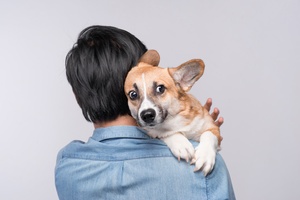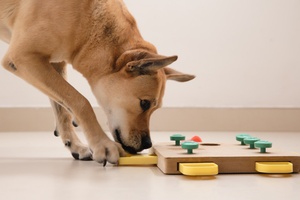Similar to people, dogs can develop degenerative brain problems as they age. Dog dementia or canine cognitive dysfunction (CCD) are the terms used to describe these diseases. The signs of dog dementia are numerous. Because the warning signals may take time to manifest, dementia frequently goes misdiagnosed. Disorientation, decreased family engagement, erratic sleeping patterns, and problems with house-training are typical signs. A dog suffering from dementia may also fail to recognize a familiar face or obey orders.
If you think your dog may have CCD, you should take them to the vet. There are numerous things you can do to enhance your dog’s quality of life, despite the fact that canine dementia is a progressive disorder that cannot be treated. Drugs can lessen symptoms and stop the disease’s progression. Here are several other ways to care for a dog with dementia.
Be Patient

Canine dementia frequently results in odd actions in dogs. They could lose their housebreaking skills, become less receptive to directions, or have trouble swallowing. When they are anxious, dogs with CCD will frequently bark more than usual.
You must be patient with your dog during these transitions. Even while it can be upsetting if your dog has an accident inside, for instance, he didn’t mean to do it, and reprimanding him will only make him feel more stressed and anxious.
Ensure that Food, Water, and a Bed Is Easily Accessible
Dogs with canine dementia are more likely to experience confusion, especially if they are also dealing with eyesight problems.
Always keep water, food, and a bed in the same location for your pet to make life easier. A new piece of furniture or other items should not be placed close to his bed or water since they are more likely to run into it.
Additionally, make sure your dog’s bed is cozy and supportive. For older dogs, orthopedic dog beds are frequently the best choice since they eliminate pressure spots that might exacerbate joint problems.
Exercise Remains Vital
For canines suffering from dementia, walks are crucial since exercise is strongly correlated with brain health and emotional wellbeing. Because moderate activity increases blood flow, the brain receives more oxygen. New sights and smells are also excellent for stimulating the mind.
The greatest walks for senior dogs with dementia are leisurely ones. A challenging stroll may be too much for your pet, and it might not have the same positive effects on the brain. Allow your pet the opportunity to sniff and stroll at his own speed.
Brain Training

Playing activities that challenge the mind can keep your dog busy and potentially slow the onset of dementia. Examples include the following:
- Supporting natural foraging behaviors using a snuffle mat
- Teaching your pet simple tricks or practicing the commands they already know
- Distributing food or prizes using straightforward puzzle toys, such as a stuffed Kong
- Letting your dog search for treats that have been hidden around a room
These games should ideally be simple and brief. You don’t want to exhaust or aggravate your dog. If you see any symptoms of tension, finish the game and switch things up the next time.
Keep a Regular Schedule
The majority of dogs appreciate routines, but dogs with dementia require a strict routine. Anxiety and disorientation are two of the most prevalent signs of CCD. Lack of routine can exacerbate these issues since the dog is unable to predict when it is time to play, eat, exercise, or unwind.
Try to stay regular with your dog’s feeding, walking, and bedtime schedules if you want to aid your pet. While not always simple, doing so can help lower anxiety. Additionally, your dog may be less prone to experience nighttime confusion if you maintain a regular sleep routine.
Ensure Your Dog Can Be Recognized
Dementia can cause confusion or disorientation in dogs. During these episodes, they frequently stray from the backyard or become disoriented while out walking.
Due to these factors, a dog suffering from dementia should never be left alone. This is crucial in unfamiliar environments, insecure yards, and on hikes. Always make sure your dog has a collar with his name and phone number on it and is microchipped with the most recent information.
Change the Care
The disease of canine dementia progresses over time. Although the specifics of how each dog may be affected are impossible to anticipate, the symptoms are likely to evolve with time.

You can still form a strong attachment with your dog, no matter how your health impacts his behavior. To ensure that the dog feels safe and loved, make sure that everyone in the home is advised of these adjustments and is willing to modify how they engage with the dog.
Please be aware that older pets may have additional health issues. These can include kidney illness, diabetes, and eyesight loss. Your veterinarian has to be informed of any new symptoms in order to make a proper diagnosis.
To Sum It Up
The care of a dog with dementia is not always simple. CCD can be complicated and involves a variety of therapies. Additionally, symptoms may evolve with time. Fortunately, there are numerous ways to support keeping your dog in good health. To treat symptoms and stop the spread of the condition, your veterinarian may suggest taking medications and dietary supplements. The advice given above can be used to treat your dog’s ailment.
The most crucial thing is to show your dog a lot of love, kindness, and patience. Maintaining your dog’s calm and happiness is essential since many signs of dementia are exacerbated when he or she is worried, anxious, or confused.


